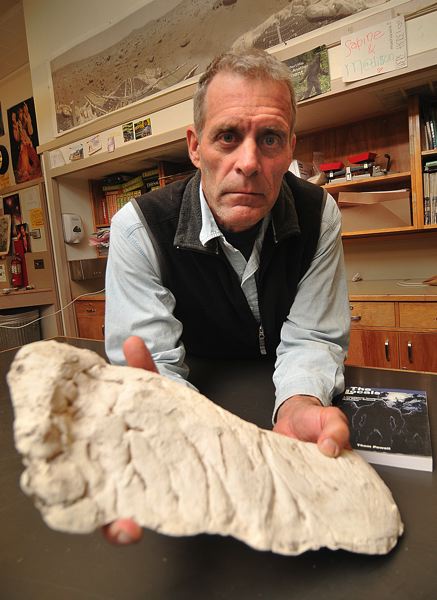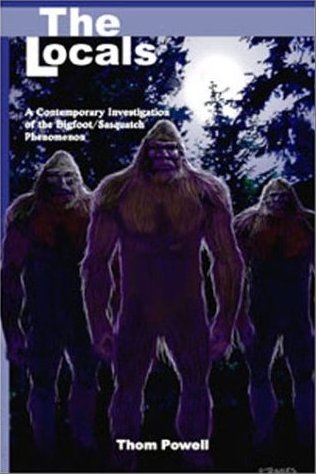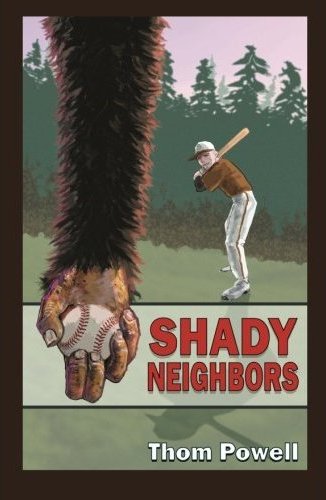Thom Powell: Hillsdale’s Sasquatch Expert
Posted by: Craig Woolheater on June 5th, 2013
At Robert Gray Middle School, teacher Thom Powell leaves a big imprint
A few months into one’s freshman year at Wilson High School, alumni of Jackson Middle School in West Portland Park will start forming friendships with those of Robert Gray in Hillsdale. They will trade stories of their middle school years, recounting horrific homework assignments and raving about favorite former teachers. But while former Jackson pupils tend to have a long and varied list, Robert Gray alums all seem to name the same one: Mr. Powell, a teacher of eighth-grade science with a penchant for Sasquatch. Not the annual music festival, but the mythical creature also known as Bigfoot.

CONNECTION PHOTO: VERN UYETAKE – Eighth-grade science teacher Thom Powell with a plaster track cast of the Sasquatch in his classroom at Robert Gray Middle School.
Thom Powell has taught at Robert Gray Middle School for nearly three decades. He is a tall, gray man with a raspy voice and a disarmingly piercing gaze. Though his appearance is domineering and almost off-putting, his students know better. They flock to his classroom as soon as the bell rings, vying for his attention to their preteen attempts at sarcasm and deadpan. Powell meets them bit for bit, speaking with complete candor to his 14-year-old pupils. Truly, he is a gentle giant, and so, he says, is the Sasquatch.
In the 1990s, looking for a fun, light way to cap lessons the day before winter break, Powell would screen footage of Bigfoot available through the school district as an example of pseudo — read: phony — science.
“I used to teach it for years just as a misapplication of science In other words, it was something that wasn’t valid science. It was fanciful; it was baloney. But it was interesting to the kids,” he recalls. “But then I moved out to (rural) Clackamas County, and in talking to some of … my neighbors, they said, ‘Oh no, this is the real deal … you don’t understand. Us folks out here in the country, we bump into these things.’… That blew my mind.”
As a man of science who studied environmental education in college in Ohio Powell sought out concrete physical evidence that Big- foot was not, in fact, baloney. He got in touch with a man near his home who was making plaster casts of tracks in the dirt that he believed were of the Sasquatch. Powell was still skeptical, but asked if he could borrow some casts as a visual aid for his lessons.
“He started setting things aside for me, and then even found a particularly good one and said, ‘Here, you can have it’, and so I started acquiring things myself, but also then started really reading the information and finding that, indeed, science is just as prejudiced as people in general can be, and this is definitely a subject that science doesn’t know what to do with because it’s not verifiable, it’s not quantifiable. You can’t run a controlled experiment for some strange reason, and the reason most people of course embrace is that … it’s fake.
“But,” Powell continues, “When you run into people who are saying, ‘Oh no’, of course you have to reconcile that. Anecdotal (evidence) does not hold water in science; people’s stories are not good enough. But when you talk to people who are credible and aren’t ballyhooing it – they’re not putting it on the Internet, they’re just saying, ‘Look, I know what saw’ — you have to factor that in.”
Powell decided to try and see if he could experience for himself what so many told him they had experienced, and became, in the late 1990s, one of the first to use motion sensor cameras to attempt to capture Bigfoot on film. Motion sensor camera, and later on, streaming video, did seem to substantiate the existence of the Sasquatch, though not in the way that he had expected.
“We never got great video, but we did get some really interesting things,” he says. “Once I was satisfied that I wasn’t being hoaxed, that were something genuine going on, then it gradually began to emerge that the problem was most likely that we’re dealing with something that’s so intelligent that it knows what you’re doing … You’re being watched when you’re putting out the cameras … they’re very sentient beings that are aware of your coming and going. One of the patterns that really became pretty vivid was that every time I would show up, everything would stop, and as soon as I would leave it would start again.”
This meant, he says, “that while you’re studying them, they’re studying you — which is pretty much what … CIA people know about intel. That’s where I started to realize ‘Okay, you’re not really doing science because we can’t do science, because they’re too intelligent, but you can do intel, you can do what spies do, and that is, you just gather all the information you can get. Nothing is verifiable, nothing is provable, but you can assemble patterns that are fairly bulletproof, and you can predict what’s going to happen next, and you can assemble a profile that matches other peoples’ profile and has predictive value.”
What Powell found was that in the Pacific Northwest, “There were certain hotspots, especially the closer you to Mount Rainier, the more stuff goes on.”
But, he adds, “They’re not just in the Pacific Northwest; they’re all over. There aren’t too many states in the United States where there isn’t some of this that goes on. As long as you’ve got forests and places where people don’t live, and the ability for nocturnal operators to move about, it appears that they’re much more widespread than people realize.”
Not just widespread, but also “much more intelligent than people realize,” Powell says. “They have capabilities that we don’t have because they’re nocturnal operators and because they’re not technologically inclined and watching TV all day, so their sensitivities are much greater than ours. They can see and operate in the night; they know you’re coming before you get there.”
Powell compares this heightened sensitivity brought on by living in nature to that of aboriginal populations in South America and Australia, which would make sense, as research into over 100 supposed Bigfoot DNA samples by Melba Ketchum, published earlier this year, purports to have proven that the Sasquatch has at least half human DNA. Powell personally agrees with her, but says going through the traditional channel of publication in a scientific journal will mean little to society at large right now.
“People are arguing for and against Ketchum’s scientific paper and the results that are described therein. In truth, her work is so, you know, out on the fringe of what’s known and accepted that only once somebody does the same work again will she gain credibility that comes from being replicated by another scientist.”
More importantly, he says, modern science can’t or won’t accommodate the possibility that such a creature exists.
“It’s a very difficult thing for the public to accept that not only are there wild creatures out there — that’s not that radical — but wild creatures that greatly resemble us,” he says. “It’s too radical, and it’s almost sort of politically too unpopular to even float. It might even destabilize the religious paradigm of the Judeo-Christian culture that we’re in; it threatens resource extraction in the federal lands — logging, mining, how much land are they entitled to — and then of course if there is another group of people, then they’re entitled to recognition and an embassy.”
Powell says the Sasquatch’s anti-industrialized ways by and large run counter to everything we know in mainstream society. While waiting for the dominant paradigm to shift, he is content with speaking at Bigfoot seminars, where he answers questions and reads passages from his two published works, “The Locals: A Contemporary Investigation of the Bigfoot/Sasquatch Phenomenon” published in 2003 and “Shady Neighbors,” a work of fiction published in 2011. Powell says members of the CIA came to a recent book signing and told him, in short, “You nailed it.”
Read the rest of the article here: Hillsdale’s Sasquatch expert
About Craig Woolheater
Co-founder of Cryptomundo in 2005.
I have appeared in or contributed to the following TV programs, documentaries and films:
OLN's Mysterious Encounters: "Caddo Critter", Southern Fried Bigfoot, Travel Channel's Weird Travels: "Bigfoot", History Channel's MonsterQuest: "Swamp Stalker", The Wild Man of the Navidad, Destination America's Monsters and Mysteries in America: Texas Terror - Lake Worth Monster, Animal Planet's Finding Bigfoot: Return to Boggy Creek and Beast of the Bayou.











The reports of sasquatchs’ extremely cautious nature and highly observent behavior defeating any attempts to place camera traps and capture them on film seems incongruent with the numerous reported sightings of the creature at night, caught in headlights as they cross roads. Doesn’t it seem difficult to believe that the same creature could observe a person placing a device in a tree, a device they could not reasonably understand, and know to avoid it, but they so frequently are unable to wait hidden near a deserted road until a loud and bright vehicle passes by and instead are seen crossing the road in front of cars?
I definitely agree with Thom Powell on a couple of points.
The first point is, that we should and must include eyewitness testimony as part of the evidence on Bigfoot. Fellow Cryptomundian, DWA, has been advocating this for some time now. Yet, it comes into question again and again. I agree with DWA and Thom Powell on that point!
The second point of agreement is, that if Bigfoot exists, it must be a highly intelligent creature, or at least extremely proficient in avoiding contact. Afterall, with all the camera technology available today, we still do not have clear photos or unshakey video. The mere fact that this proof has not happened, verifies that Bigfoot must be intelligent, if they exist. Not being captured on video is not by chance.
Eyewitness testimony today is only the folklore of tomorrow. It’s only admissible in US courts because our legal system is based on 17th century English law which was long before the acceptance of modern scientific testing methodology.
Oops forgot to mention all those zillion lawyers entitled to their McMansions and BMW’s.
In the natural world eyewitness testimony is merely suggestive. It is neither evidence or proof of anything.
Corrick: nope, eyewitness testimony is evidence. Were it not, our ancestors not only would not have made it out of caves, but never have made it into them.
You act on the evidence of your eyes every second of your life. DNA can supplement eyewitnesses; it will never replace them. People misrepresent what they see for all kinds of reasons. In the case of cryptid sightings, most of them don’t apply. For one: this is the last thing to expect someone to report if they didn’t see it.
Can’t be proof. Has to be considered. And it’s why we humans made it long before there were scientissts and courts. We trusted it enough to test it. Which is all one can do.
Eyewitness testimony is evidence, albeit evidence that can have varying levels of reliability, depending upon the duration of the sighting, the lighting and climatic conditions, the surroundngs, the other external stimuli occurring at the time, the vision of the eyewitness, and the eyewitness’ familiarty with the surroundings and subject of the sighting, among other factors.
I’ll give you two examples from my own experience of sightings I have had of medium-to-large carnivores, with very different levels of reliabilty.
A decade ago I was driving about 8:30 at night in late November or early December in northern Wisconsin on a deserted, heavily wooded stretch of highway and as I came around a bend, I saw a dark shape standing by the edge of the road for a second or two caught in my headlights before it ran off into the forest. It was dark in color, between perhaps 26 and 34 inches high at the shoulder, had ears that stuck up and a somewhat heavy but pointed muzzle. Its body was heavier than a typical wolf’s body but considerably thinner than a typical bear’s body and its legs seemed proportionately at least 30% taller than a bear’s legs typically would be. I did not notice a significant tail, but due to the brevity of the sighting and the animal’s position prior to running off, it could have had one. The sighting occurred in land that I believe was part of a state forest and I had not seen any lights from nearby homes or farms for at least 5 miles and did not see any for at least that many miles after the sighting.
The second sighting was three months ago in the snowy field behind my suburban house at about 9:00 p.m. My dog was outside, began barking much louder and more aggressively than he barks when another dog comes near, and I ran out with a powerful flashlight. I spotted two canines at a distance of about 80 yards that were about 24 to 26 inches high, about the size of an average golden retriever, darker on top than on the bottom, with pointy noses, and thick, long tails. I saw them for the length of time it took for them to run about 100 yards through the snow, up a hill and across a road, perhaps 8 seconds or so. The following day, I walked out and looked at the tracks in the snow and they were about 3-3 1/2″ across.
No one will have any problems whatsoever with me stating that that the second sighting was a pair of coyotes. I knew immediately upon spotting them that they were coyotes and subsequent evidence back up that opinion. No one in my neighborhood owns two huskies, German shephards, or similar-looking dogs and no one lets their animals wander around at night outside their yards (my dog, like most in my neighborhood, has an invisible electronic fence). A neighbor claimed earlier that day she saw three “wolves” in her back yard but the only sightings of wolves within 100+ miles of my house have been very occasional single, juvenile males chased away from a pack and wandering looking for new territory. But the footprints I saw were smaller than a wolf print and I clearly saw a nose that was thinner and pointier than a wolf muzzle, plus both animals were smaller and more lithe than any wolf I have seen. Additionally, we found out the next day that someone ran over and killed a coyote near our neighborhood earlier that evening.
But what about the first sighting – what did I see? The answer is, “I don’t know.” What I saw most resembled a Newfoundland dog, but there were no farms or homes within quite a few miles of the spot. It possibly could have been a juvenile or sick/injured black bear that was nearly starved, but bears typically go to den by that time of year (it had already snowed several times). It could have been a wolf with black or dark gray fur, maybe one that had been particularly successful with hunting over the past several weeks, which would explain its heavier appearance; there are hundreds of gray wolves in northern Wisconsin and that was in the center of their range. Wisconsin cryptid author Linda Godfrey even states that there are reports of reminant populations of the believed-to-be-long-extinct dire wolves living in northern Wisconsin and Minnesota – that animal might actually match what I saw by the side of the road, but there is no significant proof that such an animal has been alive in the past ten millenium.
The point I am trying to make is that eyewitness sightings can have very significantly different levels of reliability for identification purposes, but that does not rule them out altogether. Some such sightings can be highly reliable, a virtually certainty as far as accurate identification.
Corrick’s dismissal of eyewitness testimony as primitive and having little if any reliability, to me, demonstrates some sort of underlying bias – perhaps someone close to him (or even Corrick himself) has a criminal prosecution in his/her history that was based on eyewitness testimony? If one were to take Corrick’s opinions literally, he could be standing in front of you in person yet that would be no evidence of any sort at all that he was nearby – a silly claim. What Corrick does not understand is that evidence is not a case of all-or-nothing, zero-or-100%, black or white. The fact that eyewitness evidence may not be infallible does not render it no evidence at all. A few unreliable reports may be of little consequence, but numerous fairly reliable reports can be significant proof indeed.
Corrick–Pessimistic much? LOL Nope, you are definitely wrong about that. Your statement about eyewitness testimony ranges somewhere between pessimism to incorrect.
I think DWA and NMRNG pointed out the incorrectness of your statement, so I am not going to beat up on you by further posting why you are wrong.
NMRNG
I fully appreciate the time and effort for your reply and my thanks to you.
Maybe I wasn’t clear enough in my prior post. What I meant was that in the court of scientific testing about the physical reality of our world today, eyewitness testimony, no matter the source does not constitute proof of anything. It can be suggestive, but does it qualify as proof? No.
And the source doesn’t matter.
George Washington in an authenticated hand written letter can write he once played a game of Chess with a bigfoot. Doesn’t matter.
So let me rephrase this, in the natural scientific world eyewitness testimony is merely suggestive. It is neither evidence or proof of anything.